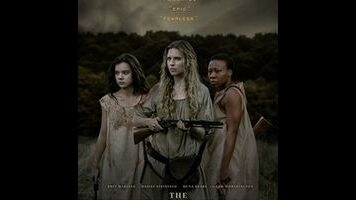Daniel Barber’s old-timey home invasion thriller has a thin veneer of novelty: It takes place around a South Carolina farmstead during the Civil War, and its bad guys are a couple of Union scouts. But despite its post-Sherman’s March setting, The Keeping Room isn’t fundamentally different from any number of backwoods-menace and rape-revenge movies, with leering Yankees swapped in for the usual snaggletoothed hicks. Like Barber’s London-set vigilante movie Harry Brown, it’s another lurid exploitation film classed up with moody lighting and character monologues, with none of the authentic regional flavor or amateur energy that gave real grindhouse flicks their tang.
After a sensationalist opening—in which a Union soldier kills a white woman before buttoning up his trousers, and his buddy executes a black witness—The Keeping Room jumps to a decrepit family farm, where Augusta (Brit Marling) tends to what’s left with the help of her teenage sister Louise (Hailee Steinfeld) and their slave Mad (Muna Otaru). There’s a germ of an internal turmoil here, with Louise still holding fast to the fantasy of the old ways, while her sister busies herself with keeping everyone safe and fed in what could be termed the “new reality” of early 1865. (See: “Like I told you, Louise, we’re all niggers now,” said in the most studious of Southern twangs.)
Sympathizing with folks left behind by war is one thing, but The Keeping Room’s representation of the Union Army through a couple of trigger-happy bogeymen-rapists named Moses (Sam Worthington) and Henry (Kyle Soller) puts it into murkier territory; this is, quite literally, a conflict of Northern aggression. Perhaps it’s because we’re now generations removed from the time when plantation life was popularly portrayed as one long song-and-dance routine that the old clichés of Southern victimhood—complete with Yankees chasing virgins around staircases and dark rooms—can be presented as revisionism.
Julia Hart’s screenplay gussies it up with some nods to feminism and to slavery’s wrongs (the source of the title), which might be more striking if the movie weren’t made this century. (And, to be honest, if The Keeping Room had anything in the way of guts, Mad would be the main character.) When it all comes down to it, The Keeping Room’s main purpose is delivering the requisite genre shocks—in this case, young women in sack dresses getting raped in four-poster beds and thick globs of fake blood spraying out of squibs. Barber’s self-serious direction and Martin Ruhe’s dim, largely handheld camerawork ensure than none of it looks as prurient as it is. As in Harry Brown, the director and cinematographer seem largely concerned with rendering outrageously lurid material in an indistinguishable funereal palette where everything is spoken like a eulogy, before a finale that feels like the opening montage of a much more interesting and inspired movie.
















![HBO teases new Euphoria, Larry David, and much more in 2026 sizzle reel [Updated]](https://img.pastemagazine.com/wp-content/avuploads/2025/12/12100344/MixCollage-12-Dec-2025-09-56-AM-9137.jpg)
























